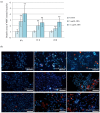Interplay of Oxidative Stress, Inflammation, and Autophagy in RAW 264.7 Murine Macrophage Cell Line Challenged with Si/SiO2 Quantum Dots
- PMID: 37512357
- PMCID: PMC10385521
- DOI: 10.3390/ma16145083
Interplay of Oxidative Stress, Inflammation, and Autophagy in RAW 264.7 Murine Macrophage Cell Line Challenged with Si/SiO2 Quantum Dots
Abstract
Quantum dots (QDs) with photostable fluorescence are recommended for imaging applications; however, their effect on living cells is incompletely understood. We aimed to elucidate the RAW 264.7 murine macrophage cell line's response to the Si/SiO2 QDs challenge. Cells were exposed to 5 and 15 μg/mL Si/SiO2 QDs for 6 h, 12 h, and 24 h. Cell metabolic activity and viability were assessed by MTT, live/dead, and dye-exclusion assays. Oxidative stress and membrane integrity were assessed by anion superoxide, malondialdehyde, and lactate dehydrogenase activity evaluations. Antioxidative enzyme activities were analyzed by kinetic spectrophotometric methods. Cytokines were analyzed with an antibody-based magnetic bead assay, PGE2 was assessed by ELISA, and Nrf-2, Bcl-2, Beclin 1, and the HSPs were analyzed by western blot. Autophagy levels were highlighted by fluorescence microscopy. The average IC50 dose for 6, 12, and 24 h was 16.1 ± 0.7 μg/mL. Although glutathione S-transferase and catalase were still upregulated after 24 h, superoxide dismutase was inhibited, which together allowed the gradual increase of malondialdehyde, anion superoxide, nitric oxide, and the loss of membrane integrity. G-CSF, IL-6, TNF-α, MIP-1β, MCP-1, Nrf-2, PGE2, and RANTES levels, as well as autophagy processes, were increased at all time intervals, as opposed to caspase 1 activity, COX-2, HSP60, and HSP70, which were only upregulated at the 6-h exposure interval. These results underscore that Si/SiO2 QDs possess significant immunotoxic effects on the RAW 264.7 macrophage cell line and stress the importance of developing effective strategies to mitigate their adverse impact.
Keywords: RAW 264.7; Si/SiO2 QDs; antioxidative enzymes; autophagy; cell membrane damage; cytokines; heat shock proteins; immunotoxicity; inflammatory response; oxidative stress.
Conflict of interest statement
The authors declare no conflict of interest.
Figures







References
-
- Ding F., Feng J., Zhang X., Sun J., Fan C., Ge Z. Responsive optical probes for deep-tissue imaging: Photoacoustics and second near-infrared fluorescence. Adv. Drug Deliv. Rev. 2021;173:141–163. - PubMed
-
- Ji X., Peng F., Zhong Y., Su Y., He Y. Fluorescent quantum dots: Synthesis, biomedical optical imaging, and biosafety assessment. Colloids Surf. B Biointerfaces. 2014;124:132–139. - PubMed
-
- Smith B.R., Gambhir S.S. Nanomaterials for In Vivo Imaging. Chem. Rev. 2017;117:901–986. - PubMed
LinkOut - more resources
Full Text Sources
Research Materials
Miscellaneous

